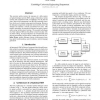Free Online Productivity Tools
i2Speak
i2Symbol
i2OCR
iTex2Img
iWeb2Print
iWeb2Shot
i2Type
iPdf2Split
iPdf2Merge
i2Bopomofo
i2Arabic
i2Style
i2Image
i2PDF
iLatex2Rtf
Sci2ools
INTERSPEECH
2010
2010
Still talking to machines (cognitively speaking)
This overview article reviews the structure of a fully statistical spoken dialogue system (SDS), using as illustration, various systems and components built at Cambridge over the last few years. Most of the components in an SDS are essentially classifiers which can be trained using supervised learning. However, the dialogue management component must track the state of the dialogue and optimise a reward accumulated over time. This requires techniques for statistical inference and policy optimisation using reinforcement learning. The potential advantages of a fully statistical SDS are the ability to train from data without hand-crafting, increased robustness to environmental noise and user uncertainty, and the ability to adapt and learn on-line.
Dialogue Management Component | INTERSPEECH 2010 | Signal Processing | Statistical Sds | Statistical Spoken Dialogue |
| Added | 19 May 2011 |
| Updated | 19 May 2011 |
| Type | Journal |
| Year | 2010 |
| Where | INTERSPEECH |
| Authors | Steve Young |
Comments (0)

